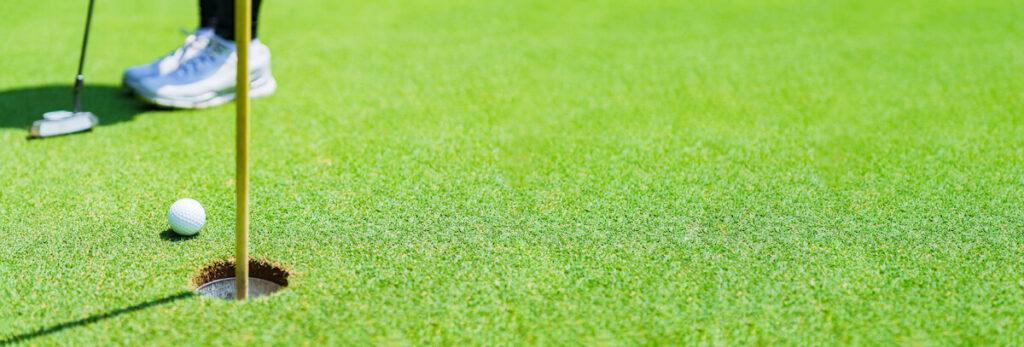How to Improve Your Golf Putting and Take Strokes off Your Game
Posted by

Have you ever gone golfing and found that you have lost your putting stroke? There’s nothing more frustrating than hitting a green in regulation and then three-putting your way to a bogey. Luckily, we’re here to help. In this guide, we’ll cover everything you need to know about golf putting.
We’ll start by defining what putting is and why it’s so important to your performance on the golf course. Then, we’ll offer some golf putting tips and drills that you can use to help improve your game and turn your bogeys into birdies.
What Is Putting?
In golf, you carry a few types of clubs in your bag. These include:
- Driver, typically used off the tee
- Woods and hybrids, used off the tee or for longer shots
- Irons, used for mid-range shots
- Wedges, used for chipping and other aspects of your short game around the green
- Putter, used when on or around the green
A putter is a short club used to roll the ball, typically on the green. Golf putting, therefore, is the act of doing so.
Why Is Golf Putting Important?

Becoming a good putter takes time and practice, but it can make a considerable difference in your game. Shot Scope — a software used to track shots, yardages, and distances — provided data on the percentage of putts made relative to a person’s handicap. Let’s start by looking at the percentage of short putts (putts within six feet) made:
| Handicap | % of short putts made within six feet |
| 0 handicap | 92.8% |
| 5 handicap | 90.2% |
| 10 handicap | 89.3% |
| 15 handicap | 84.4% |
| 20 handicap | 84% |
| 25 handicap | 82.5% |
Now, let’s look at the same percentages for putts six to 12 feet in length:
| Handicap | % of putts six to 12 feet |
| 0 handicap | 42.8% |
| 5 handicap | 41.4% |
| 10 handicap | 38.1% |
| 15 handicap | 39.6% |
| 20 handicap | 37.8% |
| 25 handicap | 35% |
This data shows a direct correlation between the ability to make putts and having a lower handicap. Look at it this way — let’s say that you three-putt every hole in an 18-hole round. That’s 54 strokes dedicated strictly to putts. If you’re trying to break 100, you would only have 45 strokes for your driver, irons, and wedges.
Now, let’s say that you two-putt every hole. This is 36 strokes toward your score — a significant difference. As a point of reference, let’s take a look at PGA tour pros. The best putters on the PGA tour average between 27 and 28 putts per round, though they’ll often have low rounds with around 21 or 22 putts.
As an amateur golfer, knowing how to putt can drastically change your game and could be the difference between breaking 100, 90, or even 80. Let’s take a look at a few golf putting drills and tips that you can use to improve your game.
How Can Golfers Improve Their Putting Strokes?
Becoming a better putter takes practice, especially because golf putting can be so challenging mentally. Below are some tips and drills that you can use to improve your golf putting and get better at golf.
1. Understand the Fundamentals
Unlike the golf swing, where generating club head speed and distance is a significant advantage, in putting, the key is consistency. A stable putting stroke where you can consistently control the speed and direction of the putt is the key to better putting.
There are many putting styles that work and even amongst the best golfers in the world, you will see a variety of putting strokes. But the key is a repeatable stroke where you can start the ball on the right line at the right speed.
To improve your golf putting, here is one method that will help many beginners who are learning how to putt. Start by identifying your target line. When you approach the ball, you should have an athletic stance. Your entire body, including your shoulders and feet, should be parallel to your target line.
The ball should be a bit forward in your stance. Your putter head should be aimed directly at your target line. You’ll then want to bring the club straight back, or on a slight arc, on your backstroke. This is similar to the backswing in your normal golf swing. However, the putter won’t come nearly as high. Your arms will act as a pendulum, with the putter never coming more than a few inches off the ground.
Keep your head down on your follow-through, and see the clubface make contact with the ball. Your feet should not leave the ground, nor should you have significant weight shift or body movement. You’re not trying to take a divot or generate a lot of speed.
2. Learn How to Read a Green
Greens have many natural breaks that will alter your putt. Understanding when putts will break left, break right, pick up speed, and decelerate can increase the likelihood of you making a putt.
One way to practice reading greens is by using the practice green for golf putting before your round. There, you can identify the speed of the greens. If you hit straight putts, you can get a better feel for how the ball responds to certain bumps and hills in the green.
3. Approach the Green With a Plan
Too often, golfers approach the green thinking they have to make every putt. While this is good in theory, it’s not necessarily practical. It can often lead to missing badly and having to three- or four-putt the green. For instance, a 15-foot downhill putt could result in a 20-foot uphill putt on the return.
Missing close to the hole is known as lag putting, and it’s something that can make a difference in your game. As this PGA article outlines, before you putt, you should ask yourself where you want to end up if you miss. Approaching the green with a plan can help cut down on unnecessary putts.
4. Practice With a Yardstick
A yardstick is one of the simplest golf putting aids available. Start by putting your golf ball on one end of the yardstick. Then, putt the ball. If you hit a straight putt, the ball should stay on the yardstick for all three feet.
If you pull the putt — meaning that the putter face is closed — then the putt will roll off the left of the yardstick (for a right-handed golfer; it would roll off the right side if you are left-hand dominant). If you push the putt — meaning that the putter face is open — then the putt would roll off the right of the yardstick (opposite for a left-handed golfer).
You can pick up this training aid at your local hardware store, and the drill is easy to do in your living room. This yardstick hack can help you see whether your ball rolls true and whether you are hitting a putt straight. If you can keep a ball on your target line for the first three feet, then you’ll have a much better chance of making your putt.
Start Working Today to Improve Your Golf Putting

Golf putting is one of the most critical aspects of the sport. Too often, amateur golfers go to the driving range and work on their drivers and irons without dedicating much time to the putting green. Learning how to putt — and subsequently gaining confidence with your putter — should help you take strokes off your game.
If you’re looking for ways to improve your golf putting, consider Skillest. Skillest connects you with golf coaches online, allowing you to take lessons from anywhere. You can even film your putting stroke from your living room and send it to your coach for feedback and drills to help you improve your game. Get started by finding an available coach and booking a putting lesson today.
